Piano Blog by Skoove – Piano Practice Tips
This week, we are going to look at jazz chords for beginners. Often even just the word ‘jazz’ can instill fear in piano students due to the genre being largely synonymous with complexity and virtuosity. I know I felt that way at a certain time. Whilst a lot of jazz music is indeed complex and many of the musicians who play it of extraordinary ability, many jazz pieces are composed of the same fundamental chords and chord progressions with variations in regard to key, modulation, tempo and structure.
What follows is a step by step breakdown of what a jazz chord is, how jazz chords are constructed, how to read jazz chord symbols, common jazz chord progressions and several practice tips along the way. By the end of reading this blog, you should have the tools and knowledge to begin learning and experimenting with jazz chords in your piano playing.
Before you read any further, for the following material to make sense, you need a good grasp of basic chord triads and intervals. The basic chord triads are Major, Minor, Diminished and Augmented.
You can see an example of the different chord types below.
Related:
Everything you need to know about piano chords
Understanding piano intervals
My previous blog explored seventh chords, which are essentially the most fundamental type of jazz chord. As soon as you add a seventh to a triad, one could say it becomes a basic jazz chord, although seventh chords are indeed used in many other genres than just jazz. Basic major and minor triads are seldom used in jazz and therefore, for the purposes of clarity, I will refer to them as basic triads.
A seventh chord can be any one of the following chords:
- Major Seventh
- Minor Seventh
- Dominant Seventh
- Minor Major Seventh
- Half Diminished Seventh
- Diminished Seventh
- Augmented Seventh
At this point, if you are unfamiliar with the first 3 types of chords on this list.
Related: Seventh chords
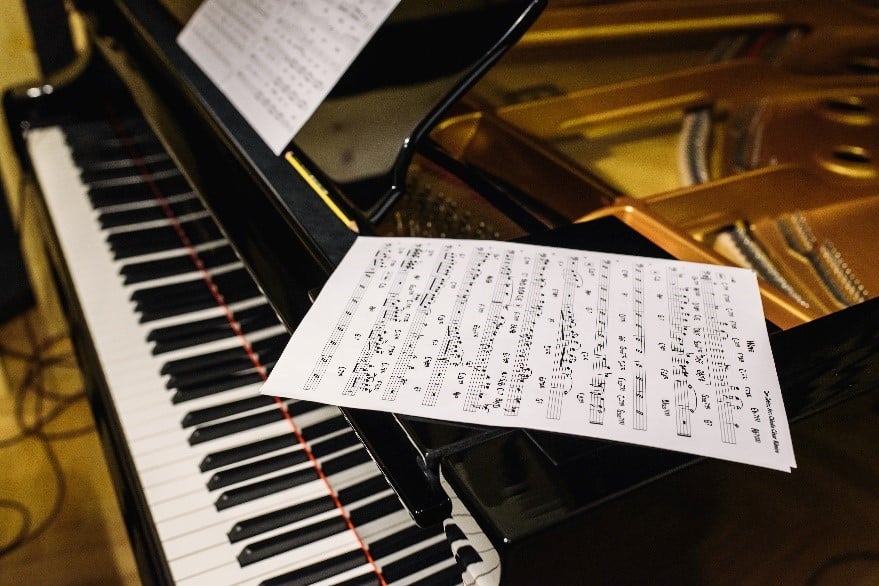
Understanding chord symbols
Jazz music is generally written out on a lead sheet. This differs from the traditional notation pianists are accustomed to in that lead sheets have the melody line written with chords written above. The reason for this is that it offers the musician the freedom to choose and improvise on how they will play the chords rather than having them all notated. In order to read a lead sheet, you need to understand the way the chords are written and what the different symbols mean.
A chord is typically defined by the root. So if we have a ‘A’ as the lowest note of the chord or in the bass part, the chord will be a A something.
Minor chords are often notated with either a minus sign ‘-‘, ‘min’ or ‘m’ after the chord note. For example, an A minor seventh chord could be written A-7, Amin7 or Am7.
Dominant chords are usually notated with simply the chord name and extension. A dominant seventh chord in D would be written D7, or if it had an extension, D9 or D13.
Major chords are notated with simply the chord name, but sometimes they may be written with a triangle like this ∆ or with ‘maj’ or ‘ma’ after the chord note. For example, a G major seventh chord could be written G, G∆, Gmaj7 or Gma7.
The above notations are the most common but there do exist variations on these, to view all the ways jazz chords can be written, check out the link here.

What is Skoove
Throughout this article you will see recommended tutorials and blogs within Skoove and here is why. Skoove is a fantastic online interactive learning platform for piano students. It breaks complex ideas and songs down into easy to understand chunks and allows you, the student, to learn at your own pace whilst giving you real time feedback on your playing. This takes a lot of potential anxiety out of your practice sessions and gives you a round-the-clock learning companion. I wish I would have had access to this when I was beginning to learn the piano. If you haven’t already, sign up for a 7-day free trial and see what you think. You’ve nothing to lose…
Extensions
An extension is when we add to an already existing structure, in this instance; we are adding to a chord. When we add extensions, we delve deeper into what makes jazz sound like jazz and what creates the tension and release it is known for. As a musician of any instrument, extensions are probably easiest to understand when they are explained using a piano due to the piano’s inherent linear sequential structure. For this reason, brass and woodwind instrumentalists often learn harmony and arranging using the piano as a visual and tactile guide.

The fundamental extension to any triad is the seventh as mentioned earlier, however because this is so fundamental, it doesn’t fall under the umbrella of what we refer to as extensions in the context of jazz. It’s what we add in addition to the seventh which we refer to as extensions and these influence the colour of the chord and subsequently mood of the music. We can add extensions to any seventh chord, provided it does not clash with the melody.
An important point to note is that sevenths do not always feature in jazz chords (for example sus chords), however they do feature in the large majority of them which is why we will start from this point.
If you take a look below, you can see the chord tones numbered from 1-13.
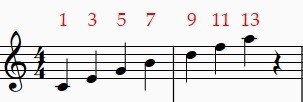
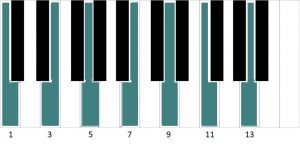
The 9th
The 9th can be added to major, minor, dominant and half diminished seventh chords. Below is an example of a C major 9 chord notated in the treble clef and also laid out on the keyboard with the chord tones written below.
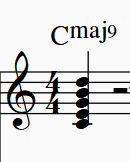
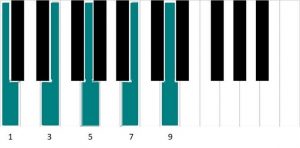
The 11th
The 11th can be added to minor, half diminished and diminished seventh chords. Below is an example of a D minor 11 chords notated in the treble clef and also laid out on the keyboard with the chord tones written below. Notice that the 9th is also included, whilst this is not mandatory, usually when you see a Dm11 the 9th is also implied.
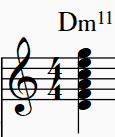
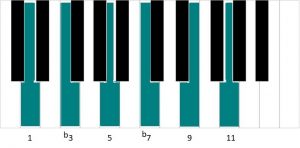
The 13th
The 13th can be added to major, minor and dominant seventh chords. Below is an example of a G13 chord notated in the treble clef and also laid out on the keyboard with the chord tones written below. Note that unlike with the previous extension, the use of the 11th in the G13 chord is not implied due to the dissonance it creates. The chord has also been constructed with more spacing than the previous two examples (more on this later).
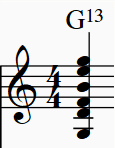
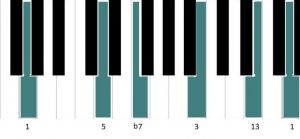
Try practicing the above chords individually, using your left hand for the bottom three notes, and your right hand for the rest.
For the purposes of this article and given that it is geared towards beginners, we will stick to looking at the Major Seventh, Minor Seventh and Dominant Seventh chords and their extensions, which incidentally are the 3 chords found in the jazz progression, the 2-5-1 (ii V I).
The ii V I progression
One of the most if not the most commonly used chord progressions in jazz music is the ii V I chord progression. If you are new to the roman numeral method of naming chords, allow me to provide a brief explanation.
Deriving from the diatonic major scale, the lower case roman numerals indicate a minor chord, whereas the upper case text indicates a major chord, however we have not yet turned this into a jazz chord progression until we add sevenths and/or extensions.
When we add sevenths to the ii V I chord we get ii7 V7 and Imaj7. In the key of C major for example this would be Dmin7, G7 and CMa7. If we add extensions to those chords, we seen earlier these can be expanded into Dmin11, G13 and Cmaj9 and many other variations.
Take a look at the above video tutorial of Autumn Leaves. This song opens with a ii-V-I chord progression, namely Cm7, F7 and Bbmaj7. Play along with the video and familiarise yourself with the melody and the bass notes. Skoove allows you to do this at your own pace and gives you feedback as you are playing along, so take your time. When you have grasped this, isolate the first 4 bars and play a Cm7 chord (C,Eb,G, Bb), an F7 chord (F, A, C, Eb) and Bbmaj7 chord (Bb, D, F, A) in time with the melody as the video is playing. Listen to how these sound. Now introduce a D (the 9th) to the top of your Cm7 chord. How does it sound? Introduce a G (the 9th) to the top of your F7 chord. Listen to how it changes the harmony. Experiment with these chords and extensions along to the Skoove tutorial and you will become more and more familiar with their sound and shape.
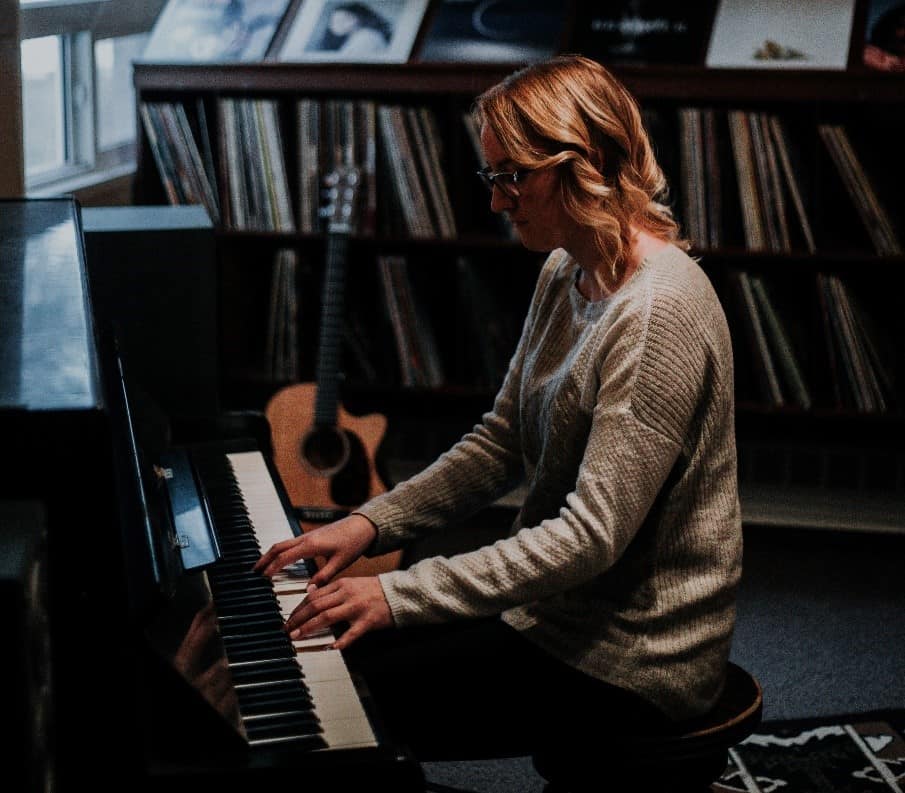
Chord Voicings
In the examples given above, chords are mainly voiced tertially (in 3rds) in order for you to see the relationships of the extensions clearly. It is helpful when beginning to learn about jazz chords to see them constructed in this way. Take a look at the Cmaj7, Dm7 and Em7 broken chords in the Skoove tutorial below. Practice along to allow your fingers to get used to the shape and to allow your brain to memorise the chord tones.
When we have understood how to build our chord in 3rds, we can invert and separate the notes out into the right and left hand, not simply because we are limited by five digits on each hand, but because playing different inversions of the jazz chord will produce different sounds, be more appropriate and make for smoother, more pleasing and interesting harmonic progression.
As a rule of thumb when voicing ii V I chords for solo piano, always play the root of the chord as the lowest note in your left hand and be sure to include the 3rd and the 7th as part of the chord. The 5th can be included or omitted depending on the sound you are wanting to create.
If we take the opening of Autumn Leaves again and this time, move away from tertially constructing the chords, we could voice the chords like this:
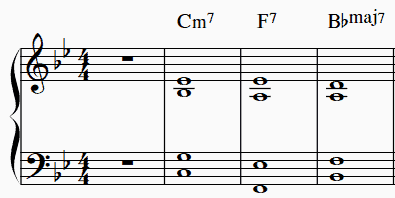
Can you see how the right hand chord changes above are smooth now rather than in a block-like fashion? This is what we are aiming towards when we voice our jazz chords. If we go a little further now and add in some extensions, it may look something like this:
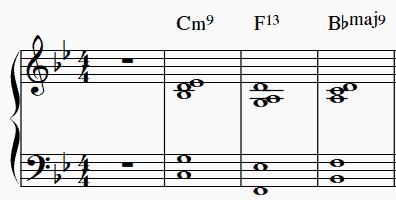
Try playing along to the first four bars of Autumn Leaves in Skoove using the above chords as accompaniment. How does it colour the melody?
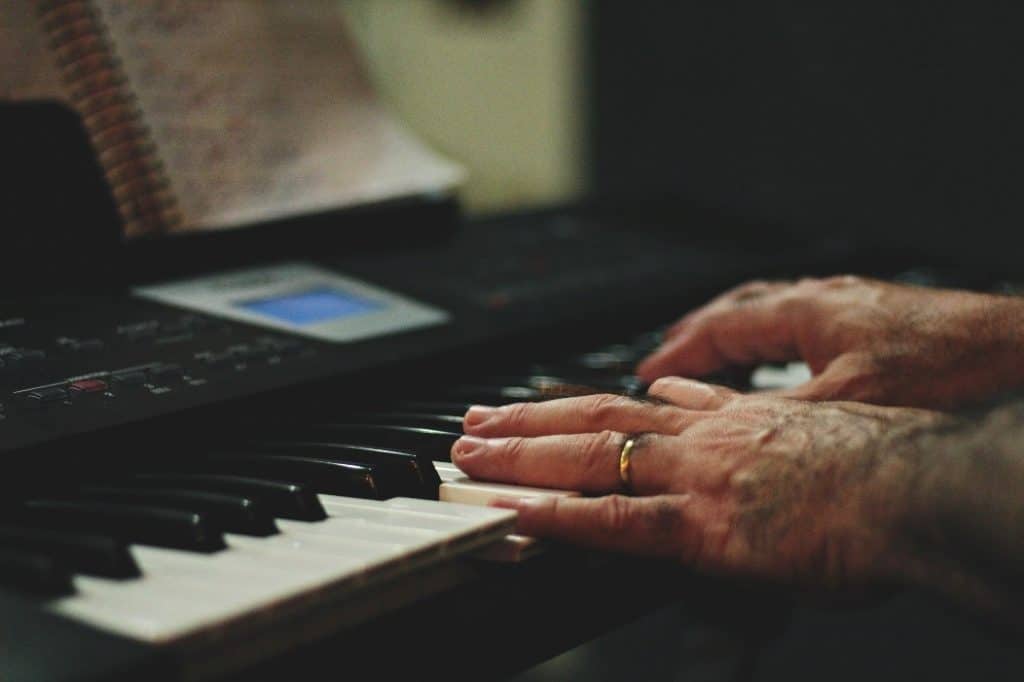
Chord shapes
There are a number of chord shapes which are helpful to build into your finger muscle memory. We are going to look at a right hand chord shape in the Skoove tutorial below:
Here, the right hand is playing a C7 chord over a funky blues bass line. Notice the chord is voiced E, G, Bb, C from the bottom up. This works perfectly fine, but if we wish to change this chord into a C9, we can substitute the C for a D so you have E, G, Bb, D. Play along with this change and see how it sounds to you. If you like the sound of it, you can perhaps make a note of the structure of it in your practice journal.
Next, try changing the G of the chord to an A so now you have in the E, A, Bb, D from the bottom up. This creates a C13 chord, notice how the sound is similar, but has a bit more tension in there.
Practice
Like anything, if you wish to improve, practice plays an invaluable part of the picture.
Related: The art of piano practice
In my own experience, the most valuable form of practice after you have gained some insight into theory is to practice jazz chords in the context of a piece of music. It is a worthwhile exercise to play chords individually and cycle ii-V-I progressions in order to familiarise oneself, but that is only part of the process. The last and most important part is to apply what you have learned to a piece of music.
A jazz standard you can do this with is Georgia On My Mind, and Skoove takes you through this classic song.
Try some of your extended jazz chords out whilst playing along with the tutorial.
Summary
Much like a child learns how to say words by listening to them and trying to mimic, before even learning how to spell or read. Listening to jazz music is a great organic way of familiarising yourself with jazz chords, chord progressions and harmonies. Pianists such as Herbie Hancock, Bill Evans, McCoy Tyner, Wynton Kelly and Thelonius Monk are just a handful of musicians I encourage you to listen to.
We didn’t get to talk about sus chords or altered chords this time round, however if you are new to jazz chords, there is plenty of material here for you to play with and explore. Dedicate some time to studying the content above and with the help of Skoove, your understanding of it will put you in good stead to move on to the more advanced jazz chords. Best of luck!

Author of this blog post

Joe is a pianist, tutor, vocalist and songwriter from Liverpool now living in the North East of Ireland. Joe studied a Degree in Music in the internationally renowned LIPA and has taught in a number of music schools in Ireland. He has been performing for over 15 years in countries including the UK, Ireland, Singapore, Norway and Spain and loves to inspire students through music.
Read More
This article is from an external source and may contain external links not controlled by Empeda Music.

